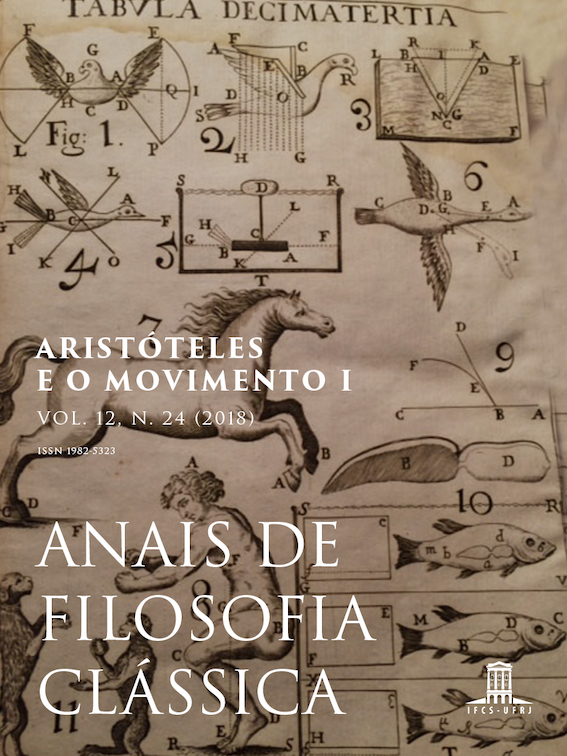Du De motu à la Génération des animaux. Une connexion oubliée du corpus aristotélicien
DOI:
https://doi.org/10.47661/afcl.v12i24.25974Keywords:
Aristotle, agent, animal, automaton, biology, finality, generation, motor, movement, necessity, patientAbstract
At first sight, Generation of animalsand Movement of animalsmeet only on particular points, and their convergence seems to be accidental. However, further investigations show that GAand MAare deeply connected. Three points deserve a particular attention. (1) The last lines of MAannounce GA’s project as the following part of a common scientific agenda. (2) Both treatises have recourse to the mechanical model of automatic puppets, in order to explain the dynamic processes they deal with (in MA: the spontaneous modification of parts which explains local motion; in GA: the persisting power of the generative mover during the process of generation). (3) In both cases, the agent-patient relation plays a fundamental role and it is set out in very similar terms. In conclusion, without formulating any hypothesis about the chronological order of the treatises, one may assume that MA(at least partly) and GAbelong to the same agenda: the explanation of the inner (or organic) movements of the animal, and especially the analysis of the relation between mover and moved. It appears, finally, that both treatises have in common a conception of organic unity, which is not jeopardized by the inner distinction between mover and moved.Downloads
References
BERRYMAN S., « Ancient Automata and Mechanical Explanation », Phronesis (48), 2003, p. 344-369.
BOS A.P., The Soul and its Instrumental Body. A Reinterpretation of Aristotle’s Philosophy of Living Nature, Leiden-Boston, Brill, 2003.
CAMBIANO G., Figure, Macchine, Sogni. Saggi sulla scienza antica, “Storia e Letteratura – 232”, Roma, Edizioni di Storia e Letteratura, 2006.
CODE A., « Soul as Efficient Cause in Aristotle's Embryology », Philosophical Topics (15), No. 2, Ancient Greek Philosophy, 1987, p. 51-59.
CORCILIUS K., Primavesi O., Aristoteles. De motu animalium. Über die Bewegung der Lebewesen, Felix Meiner Verlag, Hamburg, 2018.
FALCON A., LEFEBVRE D. (eds), Aristotle’s Generation of Animals. A Critical Guide, Cambridge University Press, Cambridge, 2018.
FEOLA G., « Alcune considerazioni sull’ordinamento del corpus biologico di Aristotele », in M.M. Sassi (a cura di), con E. Coda e G. Feola, La zoologia di Aristotele e la sua ricezione dall’età ellenistica e romana alle culture medievali, Pisa University Press, Pisa, 2017, p. 35-57.
GOTTHELF A., Teleology, First Principles and Scientific Method in Aristotle’s Biology, Oxford, Oxford University Press, 2012.
GREGORIC P., KUHAR M., « Aristotle’s Physiology of Animal Motion: On Neura and Muscles », Apeiron, 2013, p. 1-22.
HENRY D., « Embryological Models in Ancient Philosophy », Phronesis (50), 2005, p. 1-42.
HENRY D., « Aristotle on Epigenesis. Two Senses of Epigenesis », in A. Falcon, D. Lefebvre (eds), Aristotle’s Generation of Animals. A Critical Guide, Cambridge University Press, Cambridge, 2018, p. 89-107.
LENNOX J.G., Aristotle’s Philosophy of Biology. Studies in the Origins of Life Science, Cambridge, Cambridge University Press, 2001.
LEUNISSEN M., « Order and Method in Aristotle’s Generation of Animals 2 », in A. Falcon, D. Lefebvre (eds), Aristotle’s Generation of Animals. A Critical Guide, Cambridge University Press, Cambridge, 2018, p. 56-74.
MOREL P.-M., De la matière à l’action. Aristote et le problème du vivant, Paris, Vrin, Coll. “Tradition de la pensée classique”, 2007 (20162).
MOREL P.-M., « Aristote contre Démocrite, sur l’embryon », in L. Brisson, M.-H. Congourdeau, J.-L. Solère (éd.), L’embryon : formation et animation. Antiquité grecque et latine, traditions hébraïque, chrétienne et islamique, Paris, Vrin, 2008, p. 43-57.
MOREL P.-M., Aristote, Le Mouvement des animaux, La Locomotion des animaux, Traduction, introduction et notes, Paris, GF-Flammarion, 2013.
MOREL P.-M., « ‘La nature ne fait rien en vain’. Sur la causalité finale dans la Locomotion des animaux d’Aristote », Philosophie antique 16, 2016, p. 9-30.
NUSSBAUM M.C., Aristotle’s De Motu Animalium, Text with Translation, Commentary, and Interpretive Essays, Princeton, Princeton University Press, 1978, 19852.
PELLEGRIN P., « De l’explication causale dans la biologie d’Aristote », Revue de Métaphysique et de Morale, 1990-2, p. 197-219.
PELLEGRIN P., « What is Aristotle’s Generation of Animals about ? », in A. Falcon, D. Lefebvre (eds), Aristotle’s Generation of Animals. A Critical Guide, Cambridge University Press, Cambridge, 2018, p. 77-88


